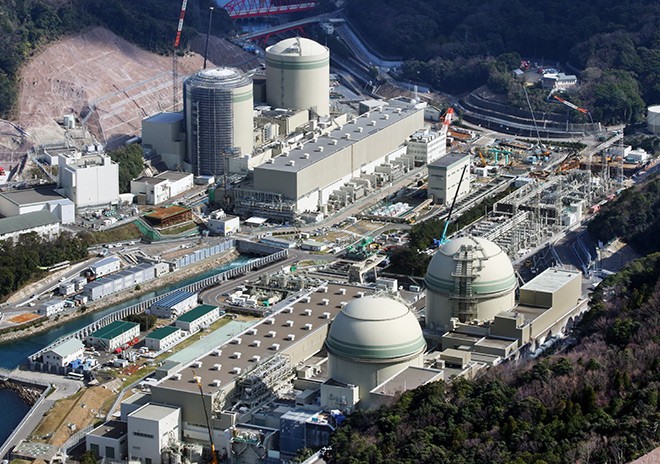April 29, 2021 at 16:14 JST
 The No. 1 and No. 2 reactors, seen in the background, at Kansai Electric Power Co.’s Takahama nuclear plant in Takahama, Fukui Prefecture, in November 2020 (Asahi Shimbun file photo)
The No. 1 and No. 2 reactors, seen in the background, at Kansai Electric Power Co.’s Takahama nuclear plant in Takahama, Fukui Prefecture, in November 2020 (Asahi Shimbun file photo)
When push came to shove, Fukui Governor Tatsuji Sugimoto went silent on his demand that resuming operations at three aging nuclear reactors in Fukui hinged on storing spent nuclear fuel outside his prefecture.
Sugimoto announced at a news conference on April 28 that he was approving the resumption of operations at the Takahama and Mihama nuclear power plants, but made no mention of setting up an interim storage facility or spent nuclear fuel until reporters asked him about it.
While Sugimoto said he confirmed the matter during an April 27 online meeting with Takashi Morimoto, president of Kansai Electric Power Co., the operator of the two nuclear plants in Fukui, the governor did not elaborate.
“Kansai Electric has indicated it was prepared and the central government has also taken the initiative in dealing with the issue," he only said. "I believe a certain set of conditions have been met.”
Last October, Sugimoto clearly said an interim storage facility for spent nuclear fuel had to be constructed outside of Fukui before he would give the green light to resume operations at the two aging nuclear plants. A major concern among local residents was that the spent fuel would be kept on the grounds of the nuclear plants indefinitely.
In February, Kansai Electric officials informed Sugimoto that one option was to have the utility join in the intermediate storage facility in Mutsu, Aomori Prefecture, to be operated by the Recyclable-Fuel Storage Co. (RFS), starting in fiscal 2021.
RFS was jointly established by Tokyo Electric Power Co. and Japan Atomic Power Co. Under the original plan, spent nuclear fuel from only those two companies was to be stored at the Mutsu facility in the northern prefecture.
The new proposal to allow all utilities operating nuclear plants to send spent nuclear fuel to the Mutsu facility led to immediate condemnation of the plan by Mutsu Mayor Soichiro Miyashita, halting progress on using that facility by Kansai Electric.
That led to a fierce lobbying effort by central government officials and Kansai Electric to get Sugimoto to soften his stance about the storage facility.
In February, Shin Hosaka, commissioner of the Agency for Natural Resources and Energy, and Morimoto went to the Fukui prefectural government building to meet with Sugimoto. Hiroshi Kajiyama, the economy minister, took part online and said he would work closely with Kansai Electric to deal with the matter.
Sugimoto apparently considered those comments as sufficient because he no longer insisted on tying resumption of operations to having a storage facility outside of Fukui.
But when Sugimoto asked the Fukui prefectural assembly to discuss resumption of operations in February, it refused, saying the governor had gone back on his previous words.
On April 6, Sugimoto met with Takayuki Hata, the head of the Fukui prefectural assembly, and explained the central government had proposed new grants to local governments hosting aging nuclear plants of up to 2.5 billion yen ($23 million) per nuclear plant.
That was likely the last barrier to approval as the Fukui prefectural assembly on April 23 gave its consent followed by Sugimoto’s approval on April 28.
(This article was compiled from reports by Takayuki Sato, Keibu Horikawa and Kenji Oda.)




















A peek through the music industry’s curtain at the producers who harnessed social media to help their idols go global.
A series based on diplomatic documents declassified by Japan’s Foreign Ministry
Here is a collection of first-hand accounts by “hibakusha” atomic bomb survivors.
Cooking experts, chefs and others involved in the field of food introduce their special recipes intertwined with their paths in life.
A series about Japanese-Americans and their memories of World War II